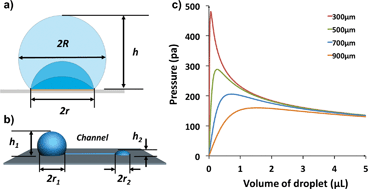Droplet-driven transports on superhydrophobic-patterned surface microfluidics†
Abstract
Droplet-based transport phenomena driven by surface tension have been explored as an automated pumping source for a number of chemical and biological applications. In this paper, we present a comprehensive theoretical and experimental investigation of unconventional droplet-based motions on a superhydrophobic-patterned surface microfluidic (S2M) platform. The S2M surfaces are monolithically fabricated using a facile two-step laser micromachining technique on regular polydimethylsiloxane (PDMS) chemistry. Unlike the traditional droplet-driven pumps built on an enclosed microfluidic network, the S2M network pins the liquid–solid interface of droplets to the lithographically defined wetting boundary and establishes a direct linkage between the volumetric and hydraulic measures. Moreover, diverse modes of droplet motions are theoretically determined and experimentally characterized in a bi-droplet configuration, among which several unconventional droplet-driven transport phenomena are first demonstrated. These include big-to-small droplet merging, droplet balancing, as well as bidirectional transporting, in addition to the classic small-to-big droplet transition. Furthermore, multi-stage programmable bidirectional pumping has been implemented on the S2M platform, according to the newly established droplet manipulation principle, to illustrate its potential use for automated biomicrofluidic and point-of-care diagnostic applications.


 Please wait while we load your content...
Please wait while we load your content...